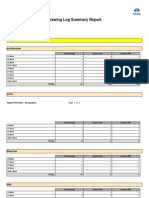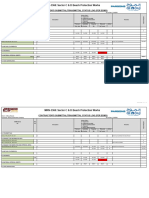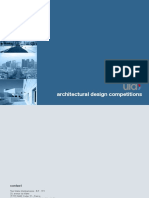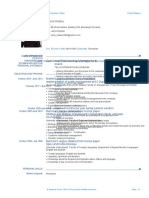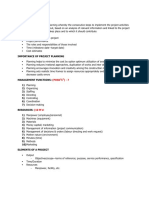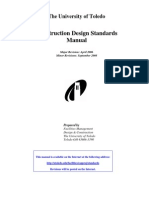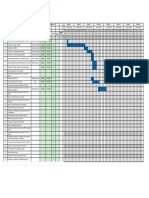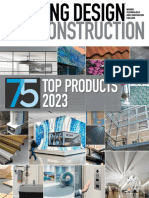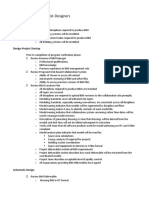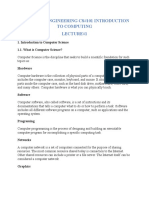Cad Standards
Cad Standards
Uploaded by
arch_ankitCopyright:
Available Formats
Cad Standards
Cad Standards
Uploaded by
arch_ankitOriginal Description:
Copyright
Available Formats
Share this document
Did you find this document useful?
Is this content inappropriate?
Copyright:
Available Formats
Cad Standards
Cad Standards
Uploaded by
arch_ankitCopyright:
Available Formats
Last updated on 9/15/09
HARVARD UNIVERSITY
HARVARD PLANNING & PROJECT
MANAGEMENT
CAD and Image Standards
for
Construction Documentation
Holyoke Center Suite 573 1350 Massachusetts Avenue Cambridge, MA 02138
t 617.496.4434 e: upo_library@harvard.edu
www.upo.harvard.edu
Last updated on 9/15/09
i. INTRODUCTION .............................................................................................. 3
1. CAD DRAWING PRODUCTION ..................................................................... 4
1. 1 FILE FORMAT and SETUP ................................................................................................................ 4
1.1.1 Electronic File Format ....................................................................................................................... 4
1.1.2 Scale, Unit, and Tolerances ............................................................................................................... 4
1.1.3 Fonts & Text Styles ........................................................................................................................... 4
1.1.4 Blocks ................................................................................................................................................ 4
1.1.5 Title Blocks........................................................................................................................................ 4
1.1.6 Policy on External Reference Files (XREFs) .................................................................................... 5
1.1.7 Policy on Image Files (JPGs, BMPs, PNGs) ..................................................................................... 5
1.1.8 Policy on Model Space and Paper Layout Space .............................................................................. 5
1.1.9 Use Disclaimer .................................................................................................................................. 5
1.2 LAYERING............................................................................................................................................. 6
1.2.1 Layer Name Formatting ..................................................................................................................... 6
1.2.2 General Rules about Names and Uses ............................................................................................... 7
1.2.3 Standard Layer Listing ...................................................................................................................... 8
1.2.4 Attributes (Colors, Linetypes, Pens) ................................................................................................ 14
1. 3 POLICY on CAD FILE TRANSLATION ........................................................................................ 15
1.3.1 Error-free AutoCAD Drawing Deliverables ................................................................................. 15
1.3.2 Translation Testing Recommended ................................................................................................. 15
2. IMAGE FILE PRODUCTION ......................................................................... 16
2.1 OVERVIEW ......................................................................................................................................... 16
2.2 IMAGE PRODUCTION ...................................................................................................................... 16
2.2.1 Content ............................................................................................................................................ 16
2.2.2 Electronic File Format ..................................................................................................................... 16
2.2.3 Resolution ........................................................................................................................................ 16
2.2.4 Bit Depth ......................................................................................................................................... 16
2.3 TIF CREATION AND CONVERSION ............................................................................................. 17
2.3.1 AutoCAD TIF Creation ................................................................................................................ 17
2.3.2. Conversion to TIF from Other File Formats ................................................................................... 17
3. SHEET IDENTIFICATION AND DELIVERY ................................................. 18
3.1 SHEET AND FILE NAMING CONVENTION ................................................................................ 18
3.1.1 Naming Construction Drawings ...................................................................................................... 18
3.1.2 Sheet Identification .......................................................................................................................... 18
APPENDICES .................................................................................................... 19
A. ELECTRONIC FILE QUALITY ASSURANCE CHECKLIST....................................................... 20
B. ELECTRONIC FILE INDEX .............................................................................................................. 21
http://www.upo.harvard.edu/CampusProjects/standards.html#cadstandards
p. 2
Last updated on 9/15/09
i. INTRODUCTION
This document outlines how to produce and deliver CAD drawings and raster images of as-built
construction drawings. For purposes of this document image files refer to the TIF format. Harvard
Planning & Project Management revised this standard in January 2009. Prior versions were published in
2006, 2002, 1999, 1996 and 1994. The revisions in this edition focus on file naming conventions and
image policies.
The purpose of this document is to serve as a tight specification for producing and delivering CAD
drawings and image files that document as-built conditions for construction projects. The guidelines are
intended to ensure consistency of materials and to maximize both short and long term usability of
construction documentation.
Before a capital project can be closed out and final payment from Harvard University rendered, all
specified materials must be submitted to the appropriate Harvard project manager or representative in
accordance with production standards and special instructions described throughout this document. See
also the publication Capital Projects Closeout Construction Documentation Requirements - Guidelines for
Architects, Contractors, and Project Managers (available at http://upo.harvard.edu) for the list of closeout
requirements.
A signed copy of the Electronic File Quality Assurance Checklist (Template 3) in the Closeout
Requirements must also be submitted with CAD drawings and image files being delivered during the
closeout phase of construction projects. In signing and submitting an Electronic Quality Assurance
Checklist, the vendor (architect, engineer, contractor, etc.) is assuring that all materials adhere to the
standards and guidelines set forth in this document.
This standard complies with the layering standard found in the AIA CAD Layer Guidelines found in the
United States National CAD Standard Version 4. The file naming convention is based on the sheet
identification format and also complies with the U.S. National CAD Standard. The layering standard
outlined herein was derived from the 1997 American Institute of Architects CAD Layer Guidelines. For
additional detail beyond what is outlined herein, please refer to the U.S. National CAD Standard for
guidance.
A copy of the current National CAD Standard may be obtained from
http://www.buildingsmartalliance.org/ncs/.
Standards for CAD drawings documenting space, for import in a space management system, are in a
separate document Harvard University Space Documentation CAD Standard.
Please direct any questions or comments about this document to the address below.
Harvard Planning & Project Management
573 Holyoke Center
1350 Massachusetts Avenue
Cambridge, MA 02138.
tel: 617-496-4434
email: upo_library@harvard.edu and james_nelson@harvard.edu
http://www.upo.harvard.edu/CampusProjects/standards.html#cadstandards
p. 3
Last updated on 9/15/09
1. CAD DRAWING PRODUCTION
1. 1 FILE FORMAT and SETUP
1.1.1 Electronic File Format
As-built construction project drawings must be submitted to Harvard University in full compliance with the
most recent or prior version of AutoCAD software at the time of submission (file extension = .DWG).
1.1.2 Scale, Unit, and Tolerances
All CAD drawing models should be drafted at full scale in architectural units, such that one drawing unit
equals one inch. Tolerances for construction drawings are implicit within professional service contracts.
1.1.3 Fonts & Text Styles
Text styles and fonts may vary, but the use of font ROMANS.shx for most applications is desirable.
Special fonts which are not packaged with AutoCAD are not allowed. Dimensions, labels and notes,
should be not less than 1/8 height on printed drawings
1.1.4 Blocks
Harvard is currently not imposing the use of any particular block definitions or block libraries. However,
Harvard requires that the following general rules be employed when handling block entities:
1. All entities within a block must be created on layer 0.
2. Drawing entities translated into blocks from non-AutoCAD systems must revert to layer 0 when
exploded.
3. File translation from other systems which result in wall blocks within the .DWG file are
unacceptable.
1.1.5 Title Blocks
Each CAD file submitted to Harvard should have only one title block. If using paper space, the title block
should be placed with its lower left hand corner point inserted at a coordinate location of (0,0,0).
Depending on the purpose of the drawing, facility documentation or construction, the drawings title block
should contain certain essential information that Harvard needs to store and retrieve each drawing in its
library.
Title Blocks for Construction Drawings
Consulting architects and engineers must use the Harvard University title block template or a modified
version provided by your Harvard client.
List of Faculties/Departments title blocks available at upo.harvard.edu\campusprojects\standards.html:
Harvard University - generic title block
Allston Development Group
At minimum, these title blocks should contain all of the information listed below.
Project Information:
Firm Name - representing the drawing author
Project Name - as specified by Harvard
Building Number - as specified by Harvard
http://www.upo.harvard.edu/CampusProjects/standards.html#cadstandards
p. 4
Last updated on 9/15/09
Building Name - specify only if the project name does not include this information already,
and the project is building specific
Project Number - assigned by the Vendor
Sheet Information:
Drawing Title - indicating the drawing content, e.g. floor plan, section, detail, etc.
Sheet Identification Must follow the Sheet Naming Convention in Section 3
Date of Drawing - Date of final revision of the record drawing
Drawing Scale - representing the intended plot scale of the drawing with title block
North Arrow
1.1.6 Policy on External Reference Files (XREFs)
Harvard will not accept the submission of any CAD drawing deliverable which contains unbound
references to external source drawing files. All externally referenced data sources that were used during
the CAD drawing production phase should be inserted and retained as a block within a single drawing file,
including the title block, upon project completion and prior to drawing delivery to Harvard. The resulting
self-contained drawing file is an acceptable deliverable to Harvard.
1.1.7 Policy on Image Files (JPGs, BMPs, PNGs)
Harvard will not accept the submission of referenced images either. All images included in a drawing must
be cut and pasted into the drawing so that they are embedded within the CAD file. Referenced images will
be discarded and therefore might cause incomplete drawings. Please be aware of this when creating your
CAD files. If it is not possible to embed the images please contact Property Information Resource Center
(PIRC) staff to determine an alternative.
1.1.8 Policy on Model Space and Paper Layout Space
Harvard requires that each CAD file submitted as a project deliverable contains only one drawing model
with one title block, using either of the following setup methods. Note that some Harvard clients may
express a preference for one method to be used instead of another. In this case, please see your Harvard
client representative for specific preferences.
Method #1 -- Model Space Only. Both the drawing model and the drawings title block are
contained in the same model space environment within a single CAD file. The
paper space environment is not used.
Method #2 -- Model Space and Paper Space Combined. Each CAD file is set up to contain only
one title block in paper space which references the building model contained in
model space.
1.1.9 Use Disclaimer
All construction documents must include the following disclaimer (already placed on the Harvard border
template): Warning: This document may contain sensitive and/or proprietary information and therefore
must be treated as a confidential document. Acceptance of this document constitutes an agreement that this
document and the information contained herein shall be maintained and transmitted in a confidential
manner. No part of this document shall be reproduced, released or distributed without the express written
permission of Harvard University and any distribution to non-Harvard entities or persons must be subject
to a written confidentiality agreement.
http://www.upo.harvard.edu/CampusProjects/standards.html#cadstandards
p. 5
Last updated on 9/15/09
1.2 LAYERING
Harvard has adopted most of the layer name and use rules recommended by the CAD Layer Guidelines
published in 1997 by the American Institute of Architects (AIA). Where noted, Harvard has supplemented
the AIA guidelines with its own rules and standards, as necessary. The layering standard complies with the
AIA CAD Layer Guidelines as found in the United States National CAD Standard - Version 4. For
additional detail, beyond what is outlined herein, please refer to the National CAD Standard for guidance.
A copy of the National CAD Standard may be obtained from http://www.buildingsmartalliance.org/ncs/.
1.2.1 Layer Name Formatting
Layer names may be as short as six characters (discipline code + major group) or as long as fourteen
characters (discipline code + major group + minor group + status). Here are the four examples of
acceptable formula variations, with explanations of formula variables found below:
Layer Name Formatting
#1
#2
#3
#4
A-WALL
A-WALL-FULL
A-WALL-DEMO
A-WALL-FULLE
=
=
=
=
Discipline Code
Discipline Code
Discipline Code
Discipline Code
+
+
+
+
Major Group
Major Group
Major Group
Major Group
+
+
+
Minor Group
Status Code
Minor Group
Status Code
Discipline Code:
The discipline code is one or two character field with a designator from the table below and if
necessary an optional second character (a user defined modifier) followed by a hyphen. The
Discipline designators are the same for both layer names and file names.
Discipline Designator
A
B
C
D
E
F
G
H
I
L
M
Architectural
Geotechnical
Civil
Process
Electrical
Fire Protection
General
Hazardous Materials
Interiors
Landscape
Mechanical
O
P
Q
R
S
T
U
V
X
Z
Operations
Plumbing
Equipment
Resource
Structural
Telecommunications
University (HU defined)
Survey/Mapping
Other Disciplines
Contractor / Shop Drawings
Major Group:
The major group designation is a four-character field that identifies the building system, such as doors,
walls, windows, etc. Although most major groups are logically associated with specific discipline
codes, it is possible to combine major group codes with any of the discipline codes. For example, AWALL or I-WALL.
Minor Group:
This is an optional, four-character field for further differentiation of major groups. For example,
partial height walls (A-WALL-PART) might be differentiated from full height walls (A-WALLFULL). The following common modifiers defined by the AIA can also be used in the minor group
field:
IDEN
PATT
identification tags
cross hatching, poche
example:
example:
A-DOOR-IDEN
A-WALL-PATT
http://www.upo.harvard.edu/CampusProjects/standards.html#cadstandards
p. 6
Last updated on 9/15/09
If necessary, the minor group field may also be defined by the user, allowing additional layers to be
added to accommodate special project requirements. However, this should only be done after
checking the National CAD Standard to see if any of the predefined layer names in that list would
meet the special project requirements.
Status Field:
The status field is an optional one-character designator that indicates work status or construction
phase. Since drawings submitted at close-out are as-built, this field should be used to differentiate new
construction from existing or phases of work that must be differentiated. The status field is always the
last character of the layer name. See also the Status Field / Dominant Phase Rule below. Examples of
values defined for this field, by the AIA, are as follows:
Status Field Codes
E
N
Existing to Remain
New Work
X
0-9
Not in Contract
Phase Numbers
1.2.2 General Rules about Names and Uses
Layer uses are generally implied by the layer name. However, the following explanation of certain layer
use rules should be noted.
Status Field / Dominant Phase Rule:
This rule pertains to the use of the status field in naming layers for construction projects. Layers
representing the dominant phase of a project can be represented without a status field. For example, in
a small remodeling project, N would indicate new construction, while layers without status fields
would indicate parts of the existing building to remain. Conversely, a remodeling project consisting of
mostly new construction might use E to indicate existing to remain building systems while all layers
without a status field designator would represent new construction.
Annotation and Title Blocks:
These rules also come from the 1997 AIA CAD Layer Guidelines, which define annotation as
comprising text, dimensions, title block and sheet borders, detail references and other elements on
CAD drawings that do not represent physical aspects of a building. Annotation is designated by the
major group ANNO, which can be combined with any discipline code. Types of annotation are
designated below (asterisk represents any discipline code):
*-ANNO-DIMS
*-ANNO-KEYN
*-ANNO-LEGN
*-ANNO-NOTE notes
*-ANNO-NPLT
*-ANNO-REDL
*-ANNO-REVS
*-ANNO-SYMB
*-ANNO-TEXT
*-ANNO-TTLB
dimensions
keynotes
legends and schedules
construction lines, nonplotting information, viewports
redlines
revisions
symbols
text
title blocks and sheet borders
Annotation can be placed in both model space and paper space (see Policy on Model Space and Paper
Space on p. 5 of this document). Dimensions, symbols and keynotes would typically be placed in
model space. Legends, schedules, title blocks, and sheet borders would typically be placed in paper
space. The same layer names would be used in both cases.
http://www.upo.harvard.edu/CampusProjects/standards.html#cadstandards
p. 7
Last updated on 9/15/09
Elevations, Sections, and Three-Dimensional Drawings:
Per the 1997 AIA CAD Layer Guidelines, special groups of layers within each discipline are defined
for elevations, section, details, and three-dimensional views. Defined layer groups are as follows
(asterisk represents any discipline code):
*-ELEV
*-ELEV-IDEN
*-ELEV-OTLN
*-ELEV-PATT
elevations
component identification numbers
building outlines
textures and hatch patterns
*-SECT
*-SECT-MBND
*-SECT-MCUT
*-SECT-PATT
*-SECT-IDEN
sections
materials beyond section cut
materials cut by section
textures and hatch patterns
component identification numbers
*-DETL
*-DETL-IDEN
*-DETL-MBND
*-DETL-MCUT
*-DETL-PATT
details
component identification numbers
material beyond section cut
material cut by section
textures and hatch patterns
AIA guidelines further recommend that the minor group ELEV can be added to any major group layer
(A-WALL-ELEV, A-DOOR-ELEV, etc.) to identify information only seen in 3D views. This
facilitates integrating three-dimensional CAD models with two-dimensional plans, as shown by this
example:
A-WALL
A-WALL-ELEV
walls in plan view
wall surfaces in 3D view
Harvard Defined Layers and Discipline Category:
Harvard has defined a short list of layers designated for space management uses which should be
employed in conjunction with space documentation projects. These layers need not be used for
construction projects. All Harvard defined layers can be found appended to the partial AIA layer list
included with this document under the discipline code U (for University).
1.2.3 Standard Layer Listing
If additional names are needed for construction drafting purposes, please refer to the AIA CAD Layer
Guidelines found in the United States National CAD Standard. If that layer list is not sufficient, new layer
names may be added using the formatting rules described in this section.
Name
Architectural
A-ANNO-TEXT
A-ANNO-REDL
A-ANNO-SYMB
A-ANNO-LEGN
A-ANNO-DIMS
A-ANNO-TTLB
A-ANNO-NOTE
A-ANNO-NPLT
A-ANNO-KEYN
A-AREA
A-AREA-IDEN
LAYER
Description
ATTRIBUTE
Color
Linetype
General Text
Redlines
Symbols
Legends and schedules
Dimensions
Border and Title Block
Job Notes
Construction lines, nonplotting information, viewports
Key notes
Area calculation boundary lines
Room numbers, tenant identifications, area calcs
4-cyan
1-red
4-cyan
4-cyan
4-cyan
7-white
4-cyan
4-cyan
http://www.upo.harvard.edu/CampusProjects/standards.html#cadstandards
p. 8
continuous
continuous
continuous
continuous
continuous
continuous
continuous
continuous
continuous
continuous
continuous
Last updated on 9/15/09
A-AREA-OCCP
A-AREA-PATT
A-CLNG
A-CLNG-GRID
A-CLNG-PATT
A-CLNG-SUSP
A-DOOR
A-DOOR-IDEN
A-EQPM
A-EQPM-CLNG
A-EQPM-FIXD
A-EQPM-IDEN
A-EQPM-MOVE
A-FLOR
A-FLOR-CASE
A-FLOR-EVTR
A-FLOR-HRAL
A-FLOR-IDEN
A-FLOR-LEVL
A-FLOR-PATT
A-FLOR-SIGN
A-FLOR-SPCL
A-FLOR-STRS
A-FLOR-TPTN
A-FLOR-WDWK
A-GLAZ
A-GLAZ-FULL
A-GLAZ-IDEN
A-GLAZ-PHRT
A-GLAZ-SILL
A-ROOF
A-ROOF-LEVL
A-ROOF-OTLN
A-ROOF-PATT
A-WALL
A-WALL-INTR
A-WALL-FIRE
A-WALL-FULL
A-WALL-EXTR
A-WALL-HEAD
A-WALL-JAMB
A-WALL-MOVE
A-WALL-PATT
A-WALL-PRHT
Occupant or employee names
Area cross hatching
Ceiling information
Ceiling grid
Ceiling patterns
Suspended elements
Doors
Door number, hardware group, etc.
Equipment - built in
Ceiling-mounted or suspended equipment
Fixed equipment
Equipment identification numbers
Moveable equipment
Floor information
Casework (manufactured cabinets)
Elevator cars and equipment
Stair and balcony handrails, guard rails
Room numbers, names, targets, etc.
Level changes, ramps, pits, depressions
Paving, tile, carpet patterns
Signage
Architectural specialties (accessories, etc.)
Stair treads, escalators, ladders
Toilet partitions
Architectural woodwork (field-built cabs/counters)
Windows, curtain walls, glazed partitions
Full-height glazed walls and partitions
Window number
Windows and partial-height glazed partitions
Window sills
Roof
Level changes
Roof outline
Roof surface patterns, hatching
Walls general
Interior Building Wall
Fire wall patterning
Full-height walls, stairs and shaft walls
Exterior Building Wall
Door / window headers (on reflected ceiling plans)
Door / window jambs (on floor plans only)
Moveable partitions
Wall insulation, hatching and fill
Partial-height walls (on floor plans only)
2-yellow
1-red
4-cyan
2-yellow
4-cyan
2-yellow
2-yellow
4-cyan
1-red
9-lt grey
7-white
2-yellow
continuous
continuous
continuous
continuous
continuous
continuous
continuous
continuous
continuous
continuous
continuous
continuous
continuous
continuous
continuous
continuous
continuous
continuous
continuous
continuous
continuous
continuous
continuous
continuous
continuous
continuous
continuous
continuous
continuous
continuous
continuous
continuous
continuous
continuous
continuous
continuous
continuous
continuous
continuous
continuous
continuous
continuous
continuous
continuous
Civil
C-ANNO-DIMS
C-ANNO-LEGN
C-ANNO-NOTE
C-ANNO-SYMB
C-ANNO-TEXT
C-ANNO-TTLB
C-BLDG
C-COMM
C-FIRE
C-NGAS
Dimensions
Legends and schedules
Notes
Symbols
General Text
Border and Title Block
Proposed building footprints
Site communication/telephone poles, boxes, towers
Fire protection-hydrants, connections
Natural gas-manholes, meters, storage tanks
4-cyan
7-white
4-cyan
4-cyan
4-cyan
7-white
http://www.upo.harvard.edu/CampusProjects/standards.html#cadstandards
p. 9
continuous
continuous
continuous
continuous
continuous
continuous
continuous
continuous
continuous
Last updated on 9/15/09
C-NGAS-UNDR
C-PKNG
C-PKNG-ISLD
C-PKNG-STRP
C-PROP
C-PROP-BRNG
C-PROP-CONS
C-PROP-ESMT
C-ROAD
C-ROAD-CNTR
C-ROAD-CURB
C-SSWR
C-SSWR-UNDR
C-STRM
C-STRM-UNDR
C-TOPO
C-TOPO-RTWL
C-TOPO-SPOT
C-WATR
C-WATR-UNDR
Natural gas-underground lines
Parking lots
Parking islands
Parking lot striping, handicapped symbol
Property lines, survey benchmarks
Bearings and distance labels
Construction controls
Easements, rights-of-way, setback lines
Roadways
Center lines
Curbs
Sanitary sewer-manholes, pumping stations
Sanitary sewer-underground lines
Storm drainage catch basins, manholes
Storm drainage pipe-underground
Proposed contour lines and elevations
Retaining wall
Spot elevations
Domestic water- manholes, pumping, storage
Domestic water-underground lines
continuous
continuous
continuous
continuous
continuous
continuous
continuous
continuous
continuous
continuous
continuous
continuous
continuous
continuous
continuous
continuous
continuous
continuous
continuous
continuous
Electrical
E-ANNO-TEXT
E-ANNO-SYMB
E-ANNO-LEGN
E-ANNO-DIMS
E-ANNO-TTLB
E-ANNO-NOTE
E-1LIN
E-ALRM
E-AUXL
E-CCTV
E-COMM
E-CTRL
E-CTRL-DEVC
E-CTRL-WIRE
E-INTC
E-LITE
E-LITE-CIRC
E-LITE-CLNG
E-LITE-EMER
E-LITE-EXIT
E-LITE-FLOR
E-LITE-IDEN
E-LITE-JBOX
E-LITE-NUMB
E-LITE-ROOF
E-LITE-SPCL
E-LITE-SWCH
E-LITE-WALL
E-POWR
E-POWR-BUSW
E-POWR-CABL
E-POWR-CIRC
E-POWR-CLNG
E-POWR-EQPM
General Text
Symbols
Legends and schedules
Dimensions
Border and Title Block
Job Notes
One-line diagrams
Miscellaneous alarm system
Auxiliary systems
Closed-circuit TV
Telephone, communications outlets
Electric control system
Control system devices
Control system wiring
Intercom system
Lighting
Lighting circuits
Ceiling-mounted lighting
Emergency lighting
Exit lighting
Floor-mounted lighting
Luminaire identification and text
Junction box
Lighting circuit numbers
Roof lighting
Special lighting
Lighting-switches
Wall-mounted lighting
Power
Busways
Cable trays
Power circuits
Power-ceiling receptacles and devices
Power equipment
4-cyan
4-cyan
4-cyan
4-cyan
7-white
4-cyan
2-yellow
4-cyan
5-blue
http://www.upo.harvard.edu/CampusProjects/standards.html#cadstandards
p. 10
continuous
continuous
continuous
continuous
continuous
continuous
continuous
continuous
continuous
continuous
continuous
continuous
continuous
continuous
continuous
continuous
continuous
continuous
continuous
continuous
continuous
continuous
continuous
continuous
continuous
continuous
continuous
continuous
continuous
continuous
continuous
continuous
continuous
continuous
Last updated on 9/15/09
E-POWR-FEED
E-POWR-IDEN
E-POWR-JBOX
E-POWR-NUMB
E-POWR-OTLN
E-POWR-PANL
E-POWR-SWBD
E-POWR-URAC
E-POWR-WALL
E-RISR
E-SOUN
Feeders
Power identification, text
Junction box
Power circuit numbers
Power outline for backgrounds
Power panels
Power switchboards
Underfloor raceways
Power wall outlets and receptacles
Riser diagram
Sound/PA system
continuous
continuous
continuous
continuous
continuous
continuous
continuous
continuous
continuous
continuous
continuous
Fire Protection
F-ANNO-TEXT
F-ANNO-SYMB
F-ANNO-LEGN
F-ANNO-DIMS
F-ANNO-TTLB
F-ANNO-NOTE
F-CO2S
F-CO2S-EQPM
F-CO2S-PIPE
F-HALN
F-HALN-EQPM
F-HALN-PIPE
F-IGAS
F-IGAS-EQPM
F-IGAS-PIPE
F-PROT
F-PROT-ALRM
F-PROT-EQPM
F-PROT-SMOK
F-SPRN
F-SPRN-CLHD
F-SPRN-OTHD
F-SPRN-PIPE
F-SPRN-STAN
F-STAN
General Text
Symbols
Legends and schedules
Dimensions
Border and Title Block
Job Notes
CO2 system
CO2 equipment
CO2 sprinkler piping
Halon
Halon equipment
Halon Piping
Inert gas
Inert gas equipment
Inert gas piping
Fire protection systems
Fire alarm
Fire system equipment (hose cabinet/extinguishers)
Smoke detectors/heat sensors
Fire protection sprinkler system
Sprinkler head-ceiling
Sprinkler head-other
Sprinkler piping
Sprinkler system standpipe
Fire protection standpipe system
4-cyan
4-cyan
4-cyan
4-cyan
7-white
4-cyan
continuous
continuous
continuous
continuous
continuous
continuous
continuous
continuous
continuous
continuous
continuous
continuous
continuous
continuous
continuous
continuous
continuous
continuous
continuous
continuous
continuous
continuous
continuous
continuous
continuous
General Text
Symbols
Legends and schedules
Dimensions
Border and Title Block
Job Notes
Equipment
Moveable equipment
Furniture
Cabinetry / casement
Chairs and other seating
File cabinets
Furniture - freestanding (desks, credenzas, etc.)
Furniture numbers
Plants
Furniture system panels
4-cyan
4-cyan
4-cyan
4-cyan
7-white
4-cyan
continuous
continuous
continuous
continuous
continuous
continuous
continuous
continuous
continuous
continuous
continuous
continuous
continuous
continuous
continuous
continuous
Interior
I-ANNO-TEXT
I-ANNO-SYMB
I-ANNO-LEGN
I-ANNO-DIMS
I-ANNO-TTLB
I-ANNO-NOTE
I-EQPM
I-EQPM-MOVE
I-FURN
I-FURN-CASE
I-FURN-CHAR
I-FURN-FILE
I-FURN-FREE
I-FURN-IDEN
I-FURN-PLNT
I-FURN-PNLS
1-red
1-red
4-cyan
http://www.upo.harvard.edu/CampusProjects/standards.html#cadstandards
p. 11
Last updated on 9/15/09
I-FURN-POWR
I-FURN-WKSF
Furniture system-power designation
Furniture system work surface components
continuous
continuous
Landscaping
L-ANNO-TEXT
L-ANNO-SYMB
L-ANNO-LEGN
L-ANNO-TTLB
L-ANNO-NOTE
L-PLNT
L-PLNT-BEDS
L-PLNT-GRND
L-PLNT-PLAN
L-PLNT-TREE
L-PLNT-TURF
L-SITE
L-SITE-BRDG
L-SITE-DECK
L-SITE-FENC
L-SITE-FURN
L-SITE-PLAY
L-SITE-POOL
L-SITE-SPRT
L-SITE-STEP
L-SITE-WALL
L-WALK
L-WALK-PATT
General Text
Symbols
Legends and schedules
Border and Title Block
Job Notes
Plant and landscape materials
Rock, bark, and other landscaping beds
Ground cover and vines
Planting plants
Trees
Lawn areas
Site improvements
Bridges
Decks
Fencing
Site furnishings
Play structures
Pools and spas
Sports fields
Steps
Walls
Walks and steps
Walks and steps-cross-hatch patterns
4-cyan
4-cyan
4-cyan
7-white
4-cyan
continuous
continuous
continuous
continuous
continuous
continuous
continuous
continuous
continuous
continuous
continuous
continuous
continuous
continuous
continuous
continuous
continuous
continuous
continuous
continuous
continuous
continuous
continuous
General Text
Symbols
Legends and schedules
Border and Title Block
Job Notes
Compressed air systems
Compressed air equipment
Compressed air piping
Process air equipment
Process air piping
Controls and instrumentation
Thermostats
Low voltage wiring
Chilled water systems
Chilled water equipment
Chilled water piping
Exhaust system
Exhaust system ductwork
Exhaust system equipment
Rooftop exhaust equipment
Fume hoods
Fume hood exhaust system
Hot water heating system
Hot water equipment
Hot water piping
HVAC system
HVAC ceiling diffusers
4-cyan
4-cyan
4-cyan
7-white
4-cyan
continuous
continuous
continuous
continuous
continuous
continuous
continuous
continuous
continuous
continuous
continuous
continuous
continuous
continuous
continuous
continuous
continuous
continuous
continuous
continuous
continuous
continuous
continuous
continuous
continuous
continuous
continuous
Mechanical
M-ANNO-TEXT
M-ANNO-SYMB
M-ANNO-LEGN
M-ANNO-TTLB
M-ANNO-NOTE
M-CMPA
M-CMPA-CEQP
M-CMPA-CPIP
M-CMPA-PEQP
M-CMPA-PPIP
M-CONT
M-CONT-THER
M-CONT-WIRE
M-CWTR
M-CWTR-EQPM
M-CWTR-PIPE
M-EXHS
M-EXHS-DUCT
M-EXHS-EQPM
M-EXHS-RFEQ
M-FUME-EQPM
M-FUME-EXHS
M-HOTW
M-HOTW-EQPM
M-HOTW-PIPE
M-HVAC
M-HVAC-CDFF
5-blue
http://www.upo.harvard.edu/CampusProjects/standards.html#cadstandards
p. 12
Last updated on 9/15/09
M-HVAC-DUCT
M-HVAC-EQPM
M-HVAC-ODFF
M-HVAC-RDFF
M-HVAC-SDFF
M-MDGS
M-MDGS-EQPM
M-MDGS-PIPE
M-SPCL
M-SPCL-EQPM
M-SPCL-PIPE
M-STEM
M-STEM-CONP
M-STEM-EQPM
M-STEM-HPIP
M-STEM-LPIP
M-STEM-MPIP
HVAC ductwork
HVAC equipment
HVAC other diffusers
Return air diffusers
Supply diffusers
Medical gas systems
Medical gas equipment
Medical gas piping
Special systems
Special equipment
Special piping
Steam systems
Steam systems condensate piping
Steam systems equipment
High pressure steam piping
Low pressure steam piping
Medium pressure steam piping
continuous
continuous
continuous
continuous
continuous
continuous
continuous
continuous
continuous
continuous
continuous
continuous
continuous
continuous
continuous
continuous
continuous
Plumbing
P-ANNO-TEXT
P-ANNO-SYMB
P-ANNO-LEGN
P-ANNO-TTLB
P-ANNO-NOTE
P-ACID
P-ACID-PIPE
P-DOMW
P-DOMW-CPIP
P-DOMW-EQPM
P-DOMW-HPIP
P-DOMW-RISR
P-EQPM
P-FIXT
P-SANR
P-SANR-EQPM
P-SANR-FIXT
P-SANR-FLDR
P-SANR-PIPE
P-SANR-RISR
P-STRM
P-STRM-PIPE
P-STRM-RFDR
P-STRM-RISR
General Text
Symbols
Legends and schedules
Border and Title Block
Job Notes
Acid, alkaline, oil waste systems
Acid, alkaline, oil waste piping
Domestic hot and cold water systems
Domestic cold water piping
Domestic hot and cold water equipment
Domestic hot water piping
Domestic hot and cold water risers
Plumbing - miscellaneous equipment
Plumbing fixtures, toilets, sinks
Sanitary drainage
Sanitary equipment
Plumbing fixtures
Floor drains
Sanitary piping
Sanitary risers
Storm drainage system
Storm drain piping
Roof drains
Storm drain risers
4-cyan
4-cyan
4-cyan
7-white
4-cyan
General Text
Symbols
Legends and schedules
Dimensions
Border and Title Block
Job Notes
Beams
Columns
Foundation
Piles, drilled piers
Foundation reinforcing
4-cyan
4-cyan
4-cyan
4-cyan
7-white
3-green
continuous
continuous
continuous
continuous
continuous
continuous
continuous
continuous
continuous
continuous
continuous
continuous
continuous
continuous
continuous
continuous
continuous
continuous
continuous
continuous
continuous
continuous
continuous
continuous
Structural
S-ANNO-TEXT
S-ANNO-SYMB
S-ANNO-LEGN
S-ANNO-DIMS
S-ANNO-TTLB
S-ANNO-NOTE
S-BEAM
S-COLS
S-FNDN
S-FNDN-PILE
S-FNDN-RBAR
6-magenta
http://www.upo.harvard.edu/CampusProjects/standards.html#cadstandards
p. 13
continuous
continuous
continuous
continuous
continuous
continuous
continuous
continuous
continuous
continuous
continuous
Last updated on 9/15/09
S-GRID
S-GRID-DIMS
S-GRID-EXTR
S-GRID-IDEN
S-GRID-INTR
S-WALL
Column grid
Column grid dimensions
Column grid outside building
Column grid tags
Column grid inside building
Structural bearing or shear walls
6-magenta
4-cyan
continuous
continuous
continuous
continuous
continuous
continuous
Telecomm
T-ANNO-TEXT
T-ANNO-SYMB
T-ANNO-LEGN
T-ANNO-TTLB
T-ANNO-NOTE
T-CABL
T-DIAG
T-EQPM
T-JACK
General Text
Symbols
Legends and schedules
Border and Title Block
Job Notes
Cable plan
Diagram
Equipment plan
Data/telephone jacks
4-cyan
4-cyan
4-cyan
7-white
4-cyan
continuous
continuous
continuous
continuous
continuous
continuous
continuous
continuous
continuous
4-cyan
1-red
4-cyan
4-cyan
4-cyan
7-white
4-cyan
7-whte
4-cyan
4-cyan
4-cyan
5-blue
6-magenta
5-blue
continuous
continuous
continuous
continuous
continuous
continuous
continuous
continuous
continuous
continuous
continuous
continuous
continuous
continuous
continuous
University
U-ANNO-TEXT
U-ANNO-REDL
U-ANNO-SYMB
U-ANNO-LEGN
U-ANNO-DIMS
U-ANNO-TTLB
U-ANNO-NOTE
U-ANNO-NPLT
U-ANNO-KEYN
U-SPAC-ROOM
U-SPAC-RMNO
U-SPAC-RMID
U-SPAC-GROS
U-SPAC-FLID
U-SPAC-PATT
General Text
Redlines
Symbols
Legends and schedules
Dimensions
Border and University Title Block
Job Notes
Construction lines, nonplotting information, viewports
Key notes
Net room area boundaries (polylines)
Signed or unsigned room number
Space management control number for room polylines
Gross floor area boundaries (polylines)
Space management control number for floor polylines
Area Hatching
1.2.4 Attributes (Colors, Linetypes, Pens)
Many of the layers found in the partial AIA layer list in the Standard Layer Listing on p. 8 of this
document have been assigned specific attribute values by Harvard according to the following
categories: color, pen weight, and linetype. Attributes that have not been pre-defined by Harvard may
be assigned at the discretion of the user.
Colors
Harvard recommends the use of specific colors for the layers and annotation layers most often used to
assist space documentation. The color assignment of these layers can be found in the Standard Layer
Listing. All other layers may have their colors assigned at the discretion of the client.
As a general rule for all projects, drawing entities should assume the color property of the layer on
which they reside. This means that the color of individual entities should be assigned by layer as
opposed to by entity. Entities which have been translated from other systems may fail to meet this
requirement.
Linetypes
The default linetype of each layer is typically CONTINUOUS unless otherwise specified.
http://www.upo.harvard.edu/CampusProjects/standards.html#cadstandards
p. 14
Last updated on 9/15/09
Pen Weight
The following chart shows pen weight assignments which should maximize the printed clarity of
drawings conforming to the color assignments of Harvards core layers. Other pen weights may be
assigned at the discretion of the client.
Pen #
Color
Weight
Space documentation drawing elements (including, but not limited to):
1
2
red
yellow
0.01
0.01
3
4
5
6
7
8
9
30
50
green
cyan
blue
magenta
white
dk grey
lt grey
orange
tan
0.012
0.012
0.004
0.016
0.026
0.012
0.016
0.025
0.035
furniture, casement, fixed/moveable equipment
stairs details, doors, windows & glazing, elevator cars, toilet partitions, partial height
walls
toilets
text, dimensions, legends, etc, Harvard room polylines
Harvard space tracking room numbers
structural columns, Harvard gross floor polylines
walls, exterior
walls, interior (except partial height walls)
1. 3 POLICY on CAD FILE TRANSLATION
1.3.1 Error-free AutoCAD Drawing Deliverables
Harvard University recognizes that many of its construction firms do not use the same version of
AutoCAD. However, the University expects that service providers who work with other file formats will
submit DWG formatted CAD files upon project closeout that are fully compliant with all of the standards
outlined herein, and which have no significant loss of drawing entities or project data that can result from
standard CAD file translation procedures.
All DWG files and CAD drawing entities submitted at the end of a project must be able to be manipulated
using standard AutoCAD drafting procedures. Non-compliance with this policy may result in the
rejection of CAD files submitted at project closeout in addition to delayed rendering of final project
payment. DXF files will not be accepted at project closeout as a substitution for DWG CAD file
deliverables.
1.3.2 Translation Testing Recommended
For firms translating their native CAD file format into DWG format concerned about delivering error-free
CAD files to Harvard upon project closeout, it is strongly recommended that thorough file translation
testing be conducted before the drawing development phase of the project. This will assure early detection
of file conversion issues, if any, and allow for corrective measures to be taken before the project closeout
period.
http://www.upo.harvard.edu/CampusProjects/standards.html#cadstandards
p. 15
Last updated on 9/15/09
2. IMAGE FILE PRODUCTION
2.1 OVERVIEW
The intent of this standard is to receive an image file of sufficient detail to recreate 100% of the
information contained in the hard copy original, without creating an excessively large digital file. Every
sheet in the record set of construction drawings needs to have a corresponding (1:1) image file. The image
may be produced directly from the CAD application or scanned from the hard copy. Regardless of
production method, the image file must match the content of the CAD file and hard copy for each
sheet submitted. All images must follow these image production requirements and be listed in the
electronic file index (Section 3).
.DWG
Hard
copy
.TIF
2.2 IMAGE PRODUCTION
2.2.1 Content
The image is a duplicate of the hard copy so it must contain all content outlined in the CAD Drawing
Production requirements stated in Section 1 with regard to Scale, Tolerances, Fonts, Text styles, Title
Blocks and the Use Disclaimer.
2.2.2 Electronic File Format
Construction project drawing images must be submitted to Harvard University in TIF format. The files
may be uncompressed or compressed using LZW lossless data compression. Formats other than TIF will
not be accepted.
2.2.3 Resolution
All TIF images should be created at a resolution of 300ppi. A 24x36 original will result in an image
7,200 pixels by 10,800 pixels. Higher resolution may be used if 300ppi will not accurately reproduce all
content on a sheet. Do not adjust paper settings to achieve 300ppi.
2.2.4 Bit Depth
No image should be created with a bit depth greater than 8-bit, unless prior arrangements have been made
with the Property Information Resource Center.
Bit Depth
Black and White
Grayscale
Color
1-bit
8-bit
8-bit
May not be used for images created by scanning hard copy, only to be used
in circumstances where there will be no loss of information.
Sheets in which no color is used.
Sheets in which color is used to differentiate content.
http://www.upo.harvard.edu/CampusProjects/standards.html#cadstandards
p. 16
Last updated on 9/15/09
2.3 TIF CREATION AND CONVERSION
2.3.1 AutoCAD TIF Creation
Autodesk confirms that, as of August 2009, current AutoCAD software is unable to directly convert
.DWG files to .TIF files meeting Harvards requirements. Acceptable options are outlined below.
Note: Due to the many variables in AutoCAD software version and file specifics, it is not possible to
provide detailed instructions in this document. Contact either Autodesk and/or the Property Information
Resource Center for more information.
1.
Internal AutoCAD solution: Create either a DWF or PDF file from the Plot module in
AutoCAD 2010. Once in the DWF or PDF, use a viewer to generate a TIFF image meeting
Harvard requirements.
2.
External AutoCAD solution: Use a third-party software to transfer .DWG to .TIF files. Some
options suggested by Autodesk:
PDF-Xchange
http://pdf-xchange.software.informer.com/3.0/
PDF-XChange Viewer 2.0422
http://download.cnet.com/PDF-XChange-Viewer/3000-10743_4-10598377.html
Bluebeam PDF Revu CAD Edition
http://www.bluebeam.com/web07/us/products/revu/cad/features.asp
Universal Document Converter
http://www.print-driver.com/howto/convert_autocad_to_tiff.html
TIFF Image Printer 8.0
http://www.peernet.com/tiff/autocad-to-tiff.html
3.
Non-AutoCAD solution: Generate TIF files by scanning the hard copy drawing. Setting bitdepth to 8 and selecting black and white options will help keep file sizes down, but TIF files will
be very large. JPG and PDF files will not be accepted in place of TIF files.
2.3.2. Conversion to TIF from Other File Formats
For firms converting to TIF from other image file formats, the format being converted from must be a
lossless format like PNG or GIF. Firms should not convert from a file format that uses lossy compression,
for example .JPEG, due to degradation of the image. Nor should the image be resampled in order to
increase resolution to 300ppi.
http://www.upo.harvard.edu/CampusProjects/standards.html#cadstandards
p. 17
Last updated on 9/15/09
3. SHEET IDENTIFICATION AND DELIVERY
3.1 SHEET AND FILE NAMING CONVENTION
Harvard requires that for each Sheet submitted as a project deliverable there is a corresponding DWG and
image file (i.e. TIF). The sheet and the digital files all follow the same naming convention.
3.1.1 Naming Construction Drawings
The file naming convention follows the Sheet Identification section of the United States National CAD
Standard - Version 4.0.
3.1.2 Sheet Identification
The sheet identification format is a consistent format that contains five alphanumeric characters in a
specific sequence conveying meaningful information to both the drawing creator and user. The sheet
identifier consists of three components: the discipline designator, the sheet type designator, and the sheet
sequence number followed by the drawing extension, i.e. .TIF or .DWG.
Discipline Designator
Sheet Type Designator
Sheet Sequence Number
Discipline Designator - Consists of one alphabetical character and a hyphen or two alphabetical
characters. The codes used for the discipline designator are listed in the Layer Naming Convention on
page 6. The discipline designator identifies the sheet as a member of a particular genre of drawings.
The discipline designator can be either one or two characters long. For more specific genres, such as
security (TS) or audio visual (TA) drawings, creators can use a two character designator: the first letter
indicating the genre and the second letter indicating the subset of that genre. If a discipline designator
is only one character long, a hyphen is a required place holder to ensure the consistent length of the
sheet identifier. Not all type designators are required. The standard also does not prohibit combining
different types of drawings onto the same sheet.
Sheet Type Designator Consists of one numeric character. The sheet type designator refers to the
type of information displayed in the drawing.
Sheet Type Designators
0
1
2
3
4
5
6
7
8
9
General
Plans
Elevations
Sections
Large-Scale Views
Details
Schedules and Diagrams
User Defined
User Defined
3D Representation
symbols, legends, notes, etc.
horizontal views
vertical views
sectional views, wall sections
plans, elevations, stair sections, or sections that are not details
isometrics, perspectives, photographs
Sheet Sequence Number Consists of two numeric characters. The sheet sequence number, which is
a series of sequential numbers from 01 through 99. The use of 00 is not allowed.
http://www.upo.harvard.edu/CampusProjects/standards.html#cadstandards
p. 18
Last updated on 9/15/09
APPENDICES
(see following pages)
A. Electronic File Quality Assurance Checklist
B. Electronic File Index
http://www.upo.harvard.edu/CampusProjects/standards.html#cadstandards
p. 19
Last updated on 9/15/09
APPENDIX A
A. ELECTRONIC FILE QUALITY ASSURANCE CHECKLIST
CAD drawings and image (TIF) files delivered at closeout of a capital project must be accompanied
by this checklist. When a checklist has been signed and submitted, the vendor (architect, engineer,
contractor, etc.) is assuring that all materials adhere to the standards and guidelines set forth in the Harvard
Planning & Project Managements CAD and Image Standards for Construction Documentation
publication.
FILE FORMAT AND SETUP
Electronic File Format
Scale, Units, & Tolerances
Fonts and Text Styles
Blocks
Title Blocks
Policy on Model Space and Paper Space
Policy on External Reference Files (XREFs)
LAYERING
Standard Layer List
Layer Name Formatting
General Rules about Naming and Uses
Layer Attributes (Colors, Pen weights, Linetypes)
CAD & TIF NAMING CONVENTIONS
Building and Floor Identification Codes
Discipline Identification Codes
Drawing Type Codes
Drawing Numbers
POLICY ON CAD FILE TRANSLATION
Full AutoCAD Compliance
Translation Testing Procedures (if applicable)
POLICY ON TIF TRANSLATION
Produce at 300 ppi at hard copy dimensions
Files must be uncompressed
http://www.upo.harvard.edu/CampusProjects/standards.html#cadstandards
p. 20
Last updated on 9/15/09
APPENDIX A
_______________________________________________
Name of Accountable Vendor Representative
(please print)
Phone number: ______________________________
________________________________________
Signature of Accountable Vendor Representative
Date: _______________
B. ELECTRONIC FILE INDEX
All electronic materials (CAD files, TIF files, index table files, etc.) must be delivered on CD-ROM or
DVD, formatted using Windows 2000 or higher.
Indices for files must be submitted in both paper format and electronically in Microsoft Excel (version 5.0
or later). A blank template of this form is available on the UPO website at
http://upo.harvard.edu/CampusProjects/standards.html. Images files must be created at a resolution of
300ppi at hard copy dimensions, please refer to the CAD and Image Standards for Construction
Documentation publication. Indices must contain the following information:
1.
2.
3.
4.
5.
6.
File Name
Title of Drawing
Horizontal Paper Size - measured in inches, indicate the width of the original paper drawing at its
widest horizontal dimension
Vertical Paper Size - measured in inches, indicate the length of the original paper drawing at its
widest vertical dimension
Scale - indicate the scale of the original drawing (examples: 1=20 or NTS)
Pixel Depth - indicate color, grayscale, bi-tonal
Sample Electronic File Index
PROJECT INFORMATION
Project Manager:
Kate Loosian
Name of Project:
Hemenway Gym Conversion
CAPS Project #:
FAS 05-012
CAPS Building #:
854
ELECTRONIC FILE INFORMATION
DRAWING INFORMATION
CAD FILE
INFORMATION
TIF INFORMATION
Drawing Title
Title Sheet
Architect's
Drawing
Number
T-001
CAD file
name
T-1.dwg
File
Version
2000
TIF file
name
T-001.tif
Horizontal
Dimension
30"
Vertical
Dimension
42"
Scale
1' = 20'
Pixel
Depth
Grayscale
First Floor Demolition
Plan
DT-001
D-1.dwg
2000
DT-001.tif
30"
42"
1' = 20'
Grayscale
Second and Third
Floor Demolition Plan
D-002
D-2.dwg
2000
D-001.tif
30"
42"
1' = 20'
Grayscale
Second and Third
Floor Plan
Elevations
A-001
A-002
A-2.dwg
A-3.dwg
2000
2007
A-001.tif
A-001.tif
30"
30"
42"
42"
1' = 20'
1' = 20'
Grayscale
Grayscale
Second and Third
Enlarged Stair Plan
A-003
A-4.dwg
2007
A-001.tif
30"
42"
1' = 20'
Grayscale
http://www.upo.harvard.edu/CampusProjects/standards.html#cadstandards
p. 21
You might also like
- Shop Drawing LogDocument5 pagesShop Drawing LogCivil structureNo ratings yet
- KMB Cadd ManualDocument83 pagesKMB Cadd Manualfreaky365No ratings yet
- Standard Construction DetailsDocument38 pagesStandard Construction DetailspeterNo ratings yet
- Start A New Project: Demolition Floor Plan'Document8 pagesStart A New Project: Demolition Floor Plan'api-412335502No ratings yet
- IOT RaspberryPiDocument26 pagesIOT RaspberryPiNeet BuddiesNo ratings yet
- SSH Pentest - Cheat SheetDocument1 pageSSH Pentest - Cheat Sheetregister NameNo ratings yet
- Drawing Log Summary ReportDocument5 pagesDrawing Log Summary ReportRavi Shankar KolluruNo ratings yet
- List of Structure Drawing: NO REV Drawing Number Drawing Title Scale Paper Size RevisionDocument1 pageList of Structure Drawing: NO REV Drawing Number Drawing Title Scale Paper Size RevisionDeddy Ary SuthendyNo ratings yet
- A Relational Frame Skills Training Intervention To Increase General Intelligence and Scholastic AptitudeDocument14 pagesA Relational Frame Skills Training Intervention To Increase General Intelligence and Scholastic AptitudeasdadasdasNo ratings yet
- MRN-3368: Sector C & D Beach Protection Works: Contractor'S Submittal/Transmittal Status Log (Per Edms)Document17 pagesMRN-3368: Sector C & D Beach Protection Works: Contractor'S Submittal/Transmittal Status Log (Per Edms)Rizwan KaziNo ratings yet
- Construction Document Sheet Numbers and Order: Components of The Sheet NumberDocument3 pagesConstruction Document Sheet Numbers and Order: Components of The Sheet NumberAzharudin ZoechnyNo ratings yet
- AIA Application Certificate For Payment 1Document7 pagesAIA Application Certificate For Payment 1barnabasassefaNo ratings yet
- Construction Document Phase Document Checklist: Project Name: Prepared By: SBC No.: DateDocument1 pageConstruction Document Phase Document Checklist: Project Name: Prepared By: SBC No.: DateZineddine ALICHENo ratings yet
- Drawing Log - PC 118 (Rev 6)Document29 pagesDrawing Log - PC 118 (Rev 6)Dilshad AhemadNo ratings yet
- Drawing Log Register: Project Title: DXB/XX/XX ClientDocument3 pagesDrawing Log Register: Project Title: DXB/XX/XX ClientYashasvi UtekarNo ratings yet
- UIA - Architectural Design Competitions PDFDocument32 pagesUIA - Architectural Design Competitions PDFMmmNo ratings yet
- Planned Early Submitted: E1 MATERIAL LOG @14 Sep 14 / Div. 01 16Document4 pagesPlanned Early Submitted: E1 MATERIAL LOG @14 Sep 14 / Div. 01 16stefenjohnNo ratings yet
- AIA G202 2013 Free Sample PreviewDocument5 pagesAIA G202 2013 Free Sample PreviewAri MonteiroNo ratings yet
- 2006 - Ding - Automating Code Checking For Building Designs - DesignCheck PDFDocument18 pages2006 - Ding - Automating Code Checking For Building Designs - DesignCheck PDFVicente MedianoNo ratings yet
- Autodesk Revit 2014 ContentDocument6 pagesAutodesk Revit 2014 ContentGatot HardiyantoNo ratings yet
- E203 2013CMGC - Utah PDFDocument5 pagesE203 2013CMGC - Utah PDFCarl WilliamsNo ratings yet
- 3M Facilities Engineering CAD StandardsDocument167 pages3M Facilities Engineering CAD StandardsOGonzalezRNo ratings yet
- BIM Scheduling Project Report Dec 2010Document41 pagesBIM Scheduling Project Report Dec 2010abc321987No ratings yet
- Curriculum Vitae Oana MateiuDocument2 pagesCurriculum Vitae Oana MateiuIoana Bucur-TeodorescuNo ratings yet
- Professional: Thrissur, KeralaDocument3 pagesProfessional: Thrissur, Keralamohisin743No ratings yet
- Drawing SallDocument81 pagesDrawing Sall90070878002No ratings yet
- Drofus XFDesigner UserGuideDocument43 pagesDrofus XFDesigner UserGuidemtfsfernandezNo ratings yet
- ASCENT CertExam AutoCAD 2016 PDFDocument2 pagesASCENT CertExam AutoCAD 2016 PDFSara Meric100% (1)
- EAB Baseline ScheduleDocument10 pagesEAB Baseline ScheduleHaytham SamirNo ratings yet
- Specification PDFDocument26 pagesSpecification PDFPeachy AlferosNo ratings yet
- Germany Traditional Building Design Process: Architect's Progress RecordDocument1 pageGermany Traditional Building Design Process: Architect's Progress RecordAlexandru IonescuNo ratings yet
- BIM User Manual 1Document63 pagesBIM User Manual 1ananda babu AsaravananNo ratings yet
- Bim Execution Plan Template - Georgia TechDocument18 pagesBim Execution Plan Template - Georgia TechRobert GrilloNo ratings yet
- PCM 2 NotesDocument7 pagesPCM 2 NotesMary Faye ReyesNo ratings yet
- CAD StandardsDocument92 pagesCAD StandardsDOUDOU-38No ratings yet
- Construction Design StandardsDocument51 pagesConstruction Design StandardsRajnish Mishra0% (1)
- Gantt-Chart LDocument1 pageGantt-Chart LVaibhav Sharad DhandeNo ratings yet
- 009-BIM in Bridge and Infrastructure DesignDocument183 pages009-BIM in Bridge and Infrastructure DesignengsonikaNo ratings yet
- VHACADApp GuideDocument21 pagesVHACADApp GuideRizwan MirzaNo ratings yet
- AiaDocument38 pagesAiaharrydrivesucrazyNo ratings yet
- Introduction To Industry StandardsDocument32 pagesIntroduction To Industry Standardszeu chNo ratings yet
- Civil Engineering Department: Application For Structural InspectionDocument1 pageCivil Engineering Department: Application For Structural Inspectionstarq1No ratings yet
- The 360 of BIM 360Document36 pagesThe 360 of BIM 360Macovei AlinNo ratings yet
- P001 NDa TD 0001 R0-KTDocument115 pagesP001 NDa TD 0001 R0-KTchuc_55hk_xdNo ratings yet
- Understanding The Architects Design Phases - Schematic Design Design Development Construction DocumentsDocument8 pagesUnderstanding The Architects Design Phases - Schematic Design Design Development Construction DocumentsElijah BacaoatNo ratings yet
- Competition Grid Experimenting With and Within Architecture Competitions 1nbsped 9781859467107 9780429345968 9781000701357 9781000700749 9781000700138Document240 pagesCompetition Grid Experimenting With and Within Architecture Competitions 1nbsped 9781859467107 9780429345968 9781000701357 9781000700749 9781000700138Sayuri SusukiNo ratings yet
- 02.01 - Guideline For Basic & Detail Engineering Rev 1Document15 pages02.01 - Guideline For Basic & Detail Engineering Rev 1Luis SaDGNo ratings yet
- AD1 Elements of Architectural Composition For Placemaking PDFDocument4 pagesAD1 Elements of Architectural Composition For Placemaking PDFAndre Yap100% (1)
- The Architect's Design Phases Schematic Design:: Gonzaga, Rio D. BS-ARCH 3-1Document2 pagesThe Architect's Design Phases Schematic Design:: Gonzaga, Rio D. BS-ARCH 3-1Rio GonzagaNo ratings yet
- Protocol For Construction DrawingsDocument6 pagesProtocol For Construction DrawingsJose VilleroNo ratings yet
- Checklist Typical Items For Shop Drawing ReviewDocument11 pagesChecklist Typical Items For Shop Drawing Reviewakram solimanNo ratings yet
- ALDE - Assignment 1 - DPWH Standard SpecificationsDocument5 pagesALDE - Assignment 1 - DPWH Standard SpecificationsKristia Jolina Buendia Alde100% (1)
- DRofus User-Guide Version 1.6Document104 pagesDRofus User-Guide Version 1.6nini26No ratings yet
- Rondo Steel Stud Drywall Framing Systems Installation GuideDocument6 pagesRondo Steel Stud Drywall Framing Systems Installation GuidesabbirNo ratings yet
- Profession in Architecture.: Professional Practice 1Document30 pagesProfession in Architecture.: Professional Practice 1bharath PPNo ratings yet
- Aha8526 07Document19 pagesAha8526 07kaveeshaNo ratings yet
- 4 - UK BIM Level 2 DocumentsDocument13 pages4 - UK BIM Level 2 DocumentsjapecNo ratings yet
- Building Design & Construction - 75 Top Products For 2023Document62 pagesBuilding Design & Construction - 75 Top Products For 2023luchengueNo ratings yet
- TN OSA PM BIM Checklist-Designers: Pre-PlanningDocument6 pagesTN OSA PM BIM Checklist-Designers: Pre-PlanningAshraf El-RafeiNo ratings yet
- Lecture Notes-Relationship DiagramsDocument12 pagesLecture Notes-Relationship DiagramsEmanoel NovedaNo ratings yet
- Bim Unit-01 Student Workbook 2011 FINALDocument83 pagesBim Unit-01 Student Workbook 2011 FINALadil271No ratings yet
- Understanding the Building Construction Process: Simply ExplainedFrom EverandUnderstanding the Building Construction Process: Simply ExplainedNo ratings yet
- Master Detail Page in OAF by Area51 PDFDocument31 pagesMaster Detail Page in OAF by Area51 PDFAditya Pavan MandavaNo ratings yet
- Lecture III - Types of Software Used in BanksDocument16 pagesLecture III - Types of Software Used in BanksMuhammad RamzanNo ratings yet
- Exploring IEEE Standard For Synchrophasor C37.118 With Practical ImplementationDocument6 pagesExploring IEEE Standard For Synchrophasor C37.118 With Practical ImplementationJuan SuarezNo ratings yet
- Laptop Buying Guide PDFDocument5 pagesLaptop Buying Guide PDFJohn CenaNo ratings yet
- Teachers Monitoring Tool For Learner Attendance Conversion Tool LACTsDocument2 pagesTeachers Monitoring Tool For Learner Attendance Conversion Tool LACTsGlenn Cacho GarceNo ratings yet
- Unit Iii Statistical Process Control and Process CapabilityDocument26 pagesUnit Iii Statistical Process Control and Process CapabilityDurai Raj KumarNo ratings yet
- Lab 4 - Apache Web Server InstallationDocument4 pagesLab 4 - Apache Web Server InstallationKeith Nikolai RelucioNo ratings yet
- Hydrographic Manual of 1976-81Document400 pagesHydrographic Manual of 1976-81mishazujevNo ratings yet
- Amplitude ModulationDocument43 pagesAmplitude ModulationAmiel Paul P. GonzalesNo ratings yet
- EVS93xx - 9300 Cam Profiler - v8-0 - EN PDFDocument467 pagesEVS93xx - 9300 Cam Profiler - v8-0 - EN PDFWilson Barco MoralesNo ratings yet
- Cambridge IGCSE™: Information and Communication Technology 0417/13 May/June 2022Document15 pagesCambridge IGCSE™: Information and Communication Technology 0417/13 May/June 2022Tlhokomelo SetholeNo ratings yet
- (已压缩)T4777 English manualDocument53 pages(已压缩)T4777 English manualBinhNo ratings yet
- (INFINITY ENTERPRISE PLANS) FOR CUSTOMER - Smart Infinity Enterprise Cashout Matrix 10 15 21Document4 pages(INFINITY ENTERPRISE PLANS) FOR CUSTOMER - Smart Infinity Enterprise Cashout Matrix 10 15 21Jeff Jeansen BagcatNo ratings yet
- Software Engineering CS#101 Introduction To ComputingDocument51 pagesSoftware Engineering CS#101 Introduction To Computingnaeem wazirNo ratings yet
- DriverDocument1 pageDriverIndra BaemhoNo ratings yet
- Product Guide REL670 PDFDocument105 pagesProduct Guide REL670 PDFgm29No ratings yet
- C ProgrammingDocument37 pagesC Programminganjali jadhavNo ratings yet
- Iso 9564 1 2017Document13 pagesIso 9564 1 2017mulusew atenafuNo ratings yet
- 0 PRO Sigma 688 ENDocument12 pages0 PRO Sigma 688 ENayoub ramziNo ratings yet
- Msbte QB Ste (22518)Document9 pagesMsbte QB Ste (22518)Jay BhakharNo ratings yet
- Concrete:: Meeting Today's Needs Without Compromising The Future..Document2 pagesConcrete:: Meeting Today's Needs Without Compromising The Future..Shah KhanNo ratings yet
- Microsoft Dynamics 365 Business Central - 3 Users Essentials With PEPPOLDocument1 pageMicrosoft Dynamics 365 Business Central - 3 Users Essentials With PEPPOLLoki AngelNo ratings yet
- Lyndex-Nikken Okuma Captain Series Live Tool CatalogDocument20 pagesLyndex-Nikken Okuma Captain Series Live Tool CatalogRodolfo Diego ArangoNo ratings yet
- Image-Based Laser Sensor: Identify Part Positions and Measure The Right Spot, Every TimeDocument32 pagesImage-Based Laser Sensor: Identify Part Positions and Measure The Right Spot, Every TimeMICKENo ratings yet
- Chapter 3 Lab 3-5, OSPF Challenge Lab: TopologyDocument6 pagesChapter 3 Lab 3-5, OSPF Challenge Lab: TopologyDaniel C ArayaNo ratings yet
- Tools For Mining 1Document143 pagesTools For Mining 1Joe Doel IndraNo ratings yet
- PLR-MMR January - 2024Document30 pagesPLR-MMR January - 2024arthiguruNo ratings yet
- TDS Alpha 20 Tier 3 (EN) Rev.02Document6 pagesTDS Alpha 20 Tier 3 (EN) Rev.02Diego BernalNo ratings yet






